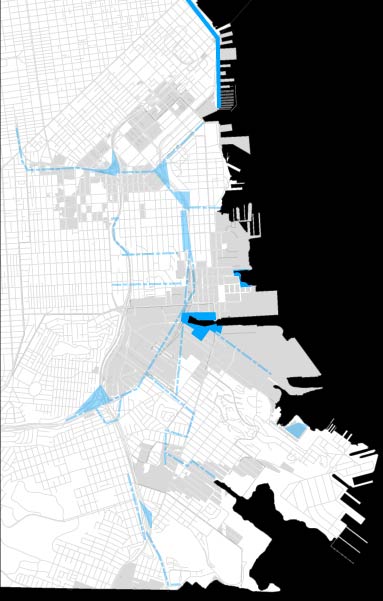

Fellows in the Piero N. Patri program conduct research and present proposals for transforming the southeast waterfront. These proposals are speculative and suggest innovative urban design concepts. Projects may overlap with existing initiatives or envision broader ideas that cross boundaries between public agencies and private stakeholders. The locations of past fellowship projects are sited on the map to the left. Click below to learn more about the projects.
FELLOWSHIP PROJECTS
2007: Envisioning Warm Water Cove2008: Imagining Islais Creek
2009: EmBIKEadero
2010: 3rd and Cargo
2011: Unaccepted Streets
2012: Website
ABOUT THE FELLOWSHIP
The Piero N. Patri Fellowship in Urban Design is a hands-on position for a current graduate student or recent graduate in urban design, architecture, landscape architecture or a related field. The fellowship provides the opportunity to gain firsthand experience working in the urban design and planning fields on a project that will have a positive impact on the city of San Francisco and the Bay Area.Fellows spend twelve weeks working on a project related to the the southeast waterfront of San Francisco. Many of these projects propose urban design plans that reimagine the land use and design of specific sites. Piero’s lifelong vision was for San Francisco’s southeast waterfront to be reconnected to the city and for that sector to benefit from the same prosperity and opportunities as the northern waterfront.
Piero N. Patri, FAIA (1929 - 2006), was an architect, urban designer and planner born and raised in San Francisco, who dedicated his life to his work and the improvement of the city. After graduating Phi Beta Kappa from the University of California at Berkeley with a Bachelor of Architecture in 1957, he was a member of the firm Patri Patri Patri with his brothers architect Remo Patri and landscape architect Tito Patri. In 1963, he and Francis L. Whisler formed Whisler-Patri. In 1996, after Whisler's retirement, the firm became Patri Merker, with partner Dana Merker, which continues today as Patri Merker Architects.
Piero N. Patri's life was filled with notable accomplishments, both in projects produced by his firm and in his pro bono work. When historic restoration and adaptive reuse was generally ignored by the architectural establishment, Piero's strong connection to San Francisco and the qualities that make it different from other American cities led the firm to explore such work. Notable projects include the conversion of the 1922 Hills Brothers coffee plant on the San Francisco waterfront to Hills Plaza, a magnificent mixed use complex; the restoration of such San Francisco Market Street landmarks as the Monadnock and Phelan buildings; as well as the 1909 Metropolitan Life headquarters on Nob Hill that houses the Ritz-Carlton Hotel. At the time of his death, Piero was deeply involved in developing plans for the adaptive reuse of the 1874 Old Mint into the San Francisco Museum and Historical Society. Notable new structures include the San Francisco Shopping Centre, a vertical mall housing Nordstrom, on Market Street; Macy's on Union Square; and a project that went into construction shortly before his death, the Intercontinental Hotel at Moscone Center (see www.patrimerker.com).
He also received numerous awards, such as the Distinguished Work and Achievement Award from the San Francisco Arts Commission, the Invaluable Service Award from the Urban Land Institute, the 2004 Silver SPUR for lifetime achievement, and the Lifetime Achievement Award from Lambda Alpha International. He was inducted as a Fellow by the American Institute of Architects in 1985.
Throughout his professional career, Piero was also a leader at SPUR, the San Francisco Planning and Urban Research Association. SPUR was established as a membership organization in 1959, to assure the continued environmental, economic and social quality of San Francisco (see www.spur.org). Piero was the first chair of the SPUR Environmental Design Committee, and in 1961 was the principal author, along with brothers Remo and Tito, and such luminaries as Donald Appleyard, then at MIT, of one of SPUR's first community plans: the Montgomery Center Plan, a visionary scheme that rethought the interconnection of the Financial District to the city, and which resulted, in a different form, in the ultimate siting of the Transamerica Pyramid. At the time of his death, Piero was Chairman of the SPUR Senior Housing Task Force.
The Piero N. Patri Fellowship was established by Piero's brother, Remo, his wife Johanna Patri, his brother Tito, and his wife, Bobby Reich Patri, in 2006, in honor of Piero N. Patri's commitment to good planning and urban design. Each year a project will be selected, with an emphasis on having a positive impact on the city of San Francisco and the Bay Area, and with a focus on a project that will encourage positive social change in the city, the region, and the urban design and planning community.